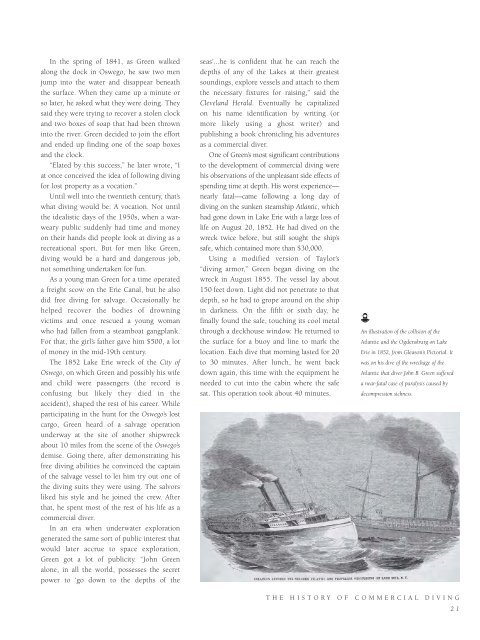Working Underwater: The Story of the Commercial Diving Industry
An illustrated history of the commercial diving industry paired with the histories of companies that have helped shape the industry.
An illustrated history of the commercial diving industry paired with the histories of companies that have helped shape the industry.
You also want an ePaper? Increase the reach of your titles
YUMPU automatically turns print PDFs into web optimized ePapers that Google loves.
In <strong>the</strong> spring <strong>of</strong> 1841, as Green walked<br />
along <strong>the</strong> dock in Oswego, he saw two men<br />
jump into <strong>the</strong> water and disappear beneath<br />
<strong>the</strong> surface. When <strong>the</strong>y came up a minute or<br />
so later, he asked what <strong>the</strong>y were doing. <strong>The</strong>y<br />
said <strong>the</strong>y were trying to recover a stolen clock<br />
and two boxes <strong>of</strong> soap that had been thrown<br />
into <strong>the</strong> river. Green decided to join <strong>the</strong> effort<br />
and ended up finding one <strong>of</strong> <strong>the</strong> soap boxes<br />
and <strong>the</strong> clock.<br />
“Elated by this success,” he later wrote, “I<br />
at once conceived <strong>the</strong> idea <strong>of</strong> following diving<br />
for lost property as a vocation.”<br />
Until well into <strong>the</strong> twentieth century, that’s<br />
what diving would be: A vocation. Not until<br />
<strong>the</strong> idealistic days <strong>of</strong> <strong>the</strong> 1950s, when a warweary<br />
public suddenly had time and money<br />
on <strong>the</strong>ir hands did people look at diving as a<br />
recreational sport. But for men like Green,<br />
diving would be a hard and dangerous job,<br />
not something undertaken for fun.<br />
As a young man Green for a time operated<br />
a freight scow on <strong>the</strong> Erie Canal, but he also<br />
did free diving for salvage. Occasionally he<br />
helped recover <strong>the</strong> bodies <strong>of</strong> drowning<br />
victims and once rescued a young woman<br />
who had fallen from a steamboat gangplank.<br />
For that, <strong>the</strong> girl’s fa<strong>the</strong>r gave him $500, a lot<br />
<strong>of</strong> money in <strong>the</strong> mid-19th century.<br />
<strong>The</strong> 1852 Lake Erie wreck <strong>of</strong> <strong>the</strong> City <strong>of</strong><br />
Oswego, on which Green and possibly his wife<br />
and child were passengers (<strong>the</strong> record is<br />
confusing but likely <strong>the</strong>y died in <strong>the</strong><br />
accident), shaped <strong>the</strong> rest <strong>of</strong> his career. While<br />
participating in <strong>the</strong> hunt for <strong>the</strong> Oswego’s lost<br />
cargo, Green heard <strong>of</strong> a salvage operation<br />
underway at <strong>the</strong> site <strong>of</strong> ano<strong>the</strong>r shipwreck<br />
about 10 miles from <strong>the</strong> scene <strong>of</strong> <strong>the</strong> Oswego’s<br />
demise. Going <strong>the</strong>re, after demonstrating his<br />
free diving abilities he convinced <strong>the</strong> captain<br />
<strong>of</strong> <strong>the</strong> salvage vessel to let him try out one <strong>of</strong><br />
<strong>the</strong> diving suits <strong>the</strong>y were using. <strong>The</strong> salvors<br />
liked his style and he joined <strong>the</strong> crew. After<br />
that, he spent most <strong>of</strong> <strong>the</strong> rest <strong>of</strong> his life as a<br />
commercial diver.<br />
In an era when underwater exploration<br />
generated <strong>the</strong> same sort <strong>of</strong> public interest that<br />
would later accrue to space exploration,<br />
Green got a lot <strong>of</strong> publicity. “John Green<br />
alone, in all <strong>the</strong> world, possesses <strong>the</strong> secret<br />
power to ‘go down to <strong>the</strong> depths <strong>of</strong> <strong>the</strong><br />
seas’...he is confident that he can reach <strong>the</strong><br />
depths <strong>of</strong> any <strong>of</strong> <strong>the</strong> Lakes at <strong>the</strong>ir greatest<br />
soundings, explore vessels and attach to <strong>the</strong>m<br />
<strong>the</strong> necessary fixtures for raising,” said <strong>the</strong><br />
Cleveland Herald. Eventually he capitalized<br />
on his name identification by writing (or<br />
more likely using a ghost writer) and<br />
publishing a book chronicling his adventures<br />
as a commercial diver.<br />
One <strong>of</strong> Green’s most significant contributions<br />
to <strong>the</strong> development <strong>of</strong> commercial diving were<br />
his observations <strong>of</strong> <strong>the</strong> unpleasant side effects <strong>of</strong><br />
spending time at depth. His worst experience—<br />
nearly fatal—came following a long day <strong>of</strong><br />
diving on <strong>the</strong> sunken steamship Atlantic, which<br />
had gone down in Lake Erie with a large loss <strong>of</strong><br />
life on August 20, 1852. He had dived on <strong>the</strong><br />
wreck twice before, but still sought <strong>the</strong> ship’s<br />
safe, which contained more than $30,000.<br />
Using a modified version <strong>of</strong> Taylor’s<br />
“diving armor,” Green began diving on <strong>the</strong><br />
wreck in August 1855. <strong>The</strong> vessel lay about<br />
150 feet down. Light did not penetrate to that<br />
depth, so he had to grope around on <strong>the</strong> ship<br />
in darkness. On <strong>the</strong> fifth or sixth day, he<br />
finally found <strong>the</strong> safe, touching its cool metal<br />
through a deckhouse window. He returned to<br />
<strong>the</strong> surface for a buoy and line to mark <strong>the</strong><br />
location. Each dive that morning lasted for 20<br />
to 30 minutes. After lunch, he went back<br />
down again, this time with <strong>the</strong> equipment he<br />
needed to cut into <strong>the</strong> cabin where <strong>the</strong> safe<br />
sat. This operation took about 40 minutes.<br />
An illustration <strong>of</strong> <strong>the</strong> collision <strong>of</strong> <strong>the</strong><br />
Atlantic and <strong>the</strong> Ogdensburg on Lake<br />
Erie in 1852, from Gleason’s Pictorial. It<br />
was on his dive <strong>of</strong> <strong>the</strong> wreckage <strong>of</strong> <strong>the</strong><br />
Atlantic that diver John B. Green suffered<br />
a near-fatal case <strong>of</strong> paralysis caused by<br />
decompression sickness.<br />
THE HISTORY OF COMMERCIAL DIVING<br />
21
















